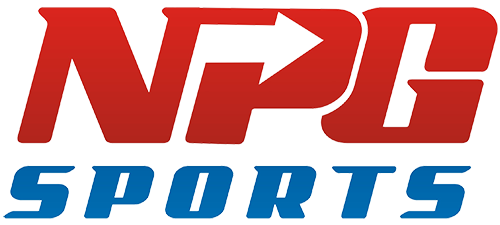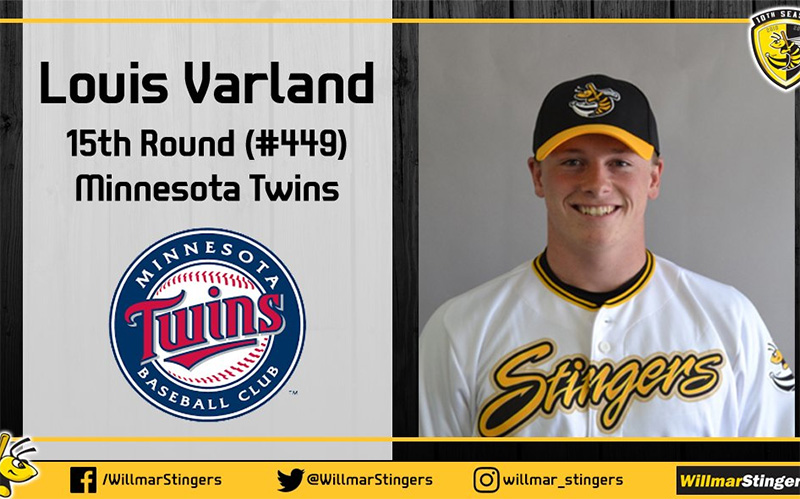Minnesota Twins prospect Twitter went atwitter when video dropped of Louie Varland hitting 100 miles per hour in a February bullpen session.
It was an incredible achievement for the North St. Paul graduate. For most of his career, Varland had been in the mid-90s, maxing at 94. In training, his velocity had been increasing but not like this. On that day,he was shooting upper 90s consistently. There were 97s, 98s, 99s, and, finally, there it was: three numbers, a dot, and another number.
And it almost didn’t happen.
Image courtesy of Image courtesy of Josh Deer, Concordia St. Paul
On what was to be his final pitch of the session, Varland hit 99.6 off the mound. It was a fantastic achievement. Had Varland been throwing at Target Field, that 99.6 would be rounded to 100 on the broadcast, an effect that Trevor May called “the TV hundge.” Still, the staff at the facility Varland has trained at begged him for one more pitch. Empty the tank, they said, give it everything and try to clear that barrier. An instructor gave Varland a “velo slap” and the right-hander took a deep breath and let it fly.
The iPad read 100.2.
The 100-mile-per-hour mark is a mystical and, too often, mythical figure for the Minnesota Twins organization. Since tracking and archiving of velocity began in 2008, the Twins have reached 100-miles-per-hour 16 times. Until 2018, they had only hit it 3 times — all by the forgettable Juan Morillo. Only the Brewers (13), Indians (13) and Diamondbacks (5) have thrown fewer triple digit fastballs than the Twins. Thankfully, in the last two seasons, Brusdar Graterol (12) and Jorge Alcala (1) helped move the Twins up the velocity leaderboard.
Maybe because of this lack of heat at the big league level, whenever a Twins prospect hits one-double-oh — regardless if it is indoors in the offseason — it draws attention.
In March, Varland returned to face hitters in live at-bats with the goal of reaching that number again. As he warmed up, he threw an effortless 97. It had an incoming sizzle that popped the catcher’s glove like a firecracker. High school players stopped their training and turned their attention to Louie’s cage.
In addition to the players and staff, another attendee was Wade Varland, Louie’s father.
Wade was tasked with setting up a GoPro on the catcher’s helmet to capture mechanics and pitch movement. But he said his real motivation was to witness his son break the century mark. He had seen the clip circulating and wanted to see him do it up close.
Asked at what point he knew he was raising two future professional athletes in Louie and older brother Gus, a member of the Dodgers organization, Wade laughed. There was no high-pressure upbringing to be pros. He had padded mats in the basement and let them run amok and be athletes as kids. He encouraged them to be competitive in all endeavors, having them play football and wrestling. They just happened to like — and eventually excel at — baseball.
As the boys got older, Wade tried to keep them hungry. Gus or Louie would spin a breaking ball or dot the corner with a fastball and Wade would just say meh. That didn’t impress him. Hell, if he had a bat in his hands, he’d hit it clear to Washington County, he’d add.
His intention was to keep them from becoming complacent. He didn’t want them to settle for pretty good, no matter what path they chose.
The key to the entire system, Wade admitted, was never to let a bat get into his hands. He’d sidestep any requests for a challenge, especially when they started to throw harder. As they got older and more cocksure, they’d beg their father to stand in and face them. Let’s see you try to knock it into the next county, they’d ask. Wade knew he didn’t stand a chance.
When Gus was in college, after years of dodging pleas and making excuses to avoid a showdown, he was finally able to put a bat into Wade’s hands. They headed to the fieldhouse on Concordia’s campus. Wade was going to face his oldest son in a live AB round. An umpire looking for some preseason work crouched behind the catcher. Players gathered around to watch. This was going to happen officially and publicly.
Wade knew he was overmatched. His son was playing in an elite college league for major league worthy prospects and was sitting 92-93. There was no way he was going to redirect anything across any adjacent county lines. Nevertheless, Wade Varland stood in there and competed, just like he had preached to his boys.
It was laughable. Gus’s fastballs slammed into the catcher’s mitt and Wade would be starting his swing. This repeated several times. Then, by the grace of baseball’s divine, Wade made contact. It was, as he described it, the latest any swing could have possibly happened, as deep into the zone as physics would allow, but the ball shot off into foul territory. It landed feet — not a county — away but it was contact.
The crowd erupted. “It was like I won gold in the Olympics,” Wade said with a chuckle.
The reason he went through this charade was because he wanted the boys to keep working, keep improving, and to never be satisfied with where they were at. That lesson seemed to take hold. Both Varland boys found themselves at a small Division II program rather than the prototypical D1 powerhouses. That didn’t stop them from working to get on the radar of professional teams.
That mindset may explain why the younger Varland, Louie, was not settling for the 99.6 and looking to hit that hundo.
Louie credits the Twins’ pitching development for unlocking this extra gear. After being drafted in the 15th round, he entered the minor league system at Elizabethton in 2019. He made three outings and started to feel discomfort in his elbow and forearm. A barrage of tests showed no signs of torn ligaments. The Twins asked him to make some adjustments to his mechanics hoping it would help him feel better and unlock some velocity.
“I had elbow climb that took my arm above my shoulder plane,” Louie said, demonstrating where his release point was and, through adjusting it by training with connection and plyo balls, where it is now (several inches lower).
Elbow climb is considered an inefficient movement and leads to a pushing action, zapped velocity, and potentially injuries. Now his arm action follows a more optimal path, mirroring his shoulder rotation. When he rotates, his elbow and forearm follow his shoulder plane rather than rising above it. He said the delivery feels more natural.
Attached Image: image_6483441.JPGOn the left, Varland pitching for the Willmer Stingers in 2019. On the right, Varland at Starters Sports Training in February 2020. Notice how much lower the elbow is compared to his head level.
With the new release point comes added challenges. At the lower point, he has to try to keep on top of the fastball to maintain a high vertical break and he’s refining his slider’s movement from the new angle. Those are two of his focuses this spring. That, and sustaining the upper 90s velocity over longer stretches. He knows he still has a long way to go. The 100 mile per hour pitch in the great indoors is fine but it’s a far cry from repeating it on the mound in a game situation.
For now, the ball keeps firing out of his hand.
During the live ABs, Varland wasn’t able to show his dad the 100 mile per hour pitch — Wade would have to settle for a 99er. The Stalker radar gun set up behind home plate registered 97s and 98s. The Rapsodo caught one at 99 while his fastball maxed out over 20 inches of vertical break (the latter datapoint excited Louie since his previous range was closer to 17 inches).
Malcolm Gladwell pointed out that one of the most useful predictors of real success is people’s willingness to persevere past the point of pretty good. Having a 94-mile-per-hour fastball is pretty good. Reaching 99.6 miles per hour is pretty dang good.
Louie Varland isn’t looking to stop at pretty good and that says a lot about him as a prospect.
Read full article here: http://twinsdaily.com/_/minnesota-twins-news/minnesota-twins/twins-prospect-louie-varland-wont-stop-at-pretty-good-r10497

